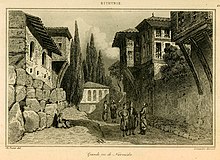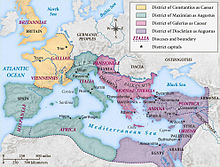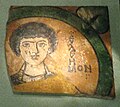Nicomedia
 French illustration of Nicomedia, 1882 | |
| Location | Turkey |
|---|---|
| Region | İzmit, Kocaeli Province |
| Coordinates | 40°45′45″N 29°55′03″E / 40.76250°N 29.91750°E |
Nicomedia (/ˌnɪkəˈmiːdiə/;[1] Greek: Νικομήδεια, Nikomedeia; modern İzmit) was an ancient Greek city located in what is now Turkey. In 286, Nicomedia became the eastern and most senior capital city of the Roman Empire (chosen by the emperor Diocletian who ruled in the east), a status which the city maintained during the Tetrarchy system (293–324).
The Tetrarchy ended with the Battle of Chrysopolis (Üsküdar) in 324, when Constantine defeated Licinius and became the sole emperor. In 330 Constantine chose for himself the nearby Byzantium (which was renamed Constantinople, modern Istanbul) as the new capital of the Roman Empire.
The city was incorporated into the
History
It was founded in 712–11 BC as a

Nicomedia was the metropolis and capital of the Roman province of Bithynia under the Roman Empire. It is referenced repeatedly in Pliny the Younger's Epistles to Trajan during his tenure as governor of Bithynia.[5] Pliny, in his letters, mentions several public buildings of the city such as a senate-house, an aqueduct, a forum, a temple of Cybele, and others, and speaks of a great fire, during which the place suffered much.[6] Diocletian made it the eastern capital city of the Roman Empire in 286 when he introduced the Tetrarchy system.
Persecutions of 303
Nicomedia was at the center of the Diocletianic Persecution of Christians which occurred under Diocletian and his Caesar Galerius. On 23 February 303 AD, the pagan festival of the Terminalia, Diocletian ordered that the newly built church at Nicomedia be razed, its scriptures burnt, and its precious stones seized.[7] The next day he issued his "First Edict Against the Christians," which ordered similar measures to be taken at churches across the Empire.
The destruction of the Nicomedia church incited panic in the city, and at the end of the month a fire destroyed part of Diocletian's palace, followed 16 days later by another fire.
Later Empire

Nicomedia remained as the eastern (and most senior) capital of the Roman Empire until co-emperor Licinius was defeated by Constantine the Great at the Battle of Chrysopolis (Üsküdar) in 324. Constantine mainly resided in Nicomedia as his interim capital city for the next six years, until in 330 he declared the nearby Byzantium (which was renamed Constantinople) the new capital. Constantine died in a royal villa in the vicinity of Nicomedia in 337. Owing to its position at the convergence of the Asiatic roads leading to the new capital, Nicomedia retained its importance even after the foundation of Constantinople.[9]
A major
In 451, the local bishopric was promoted to a
Crusades both encamped there.The city was briefly held by the
The city remained in Ottoman hands until the Battle of Ankara and subsequent Ottoman Interregnum weakened them enough for the neighbouring states to demand the return of their conquered lands from the warring Ottoman princes in exchange for their support against the other princes. In this way the Byzantines secured considerable territorial concessions including Nicomedia and other lands on the east side of the Bosphorus. However, this last period of Byzantine rule was rather short-lived, as Nicomedia was definitively taken by the Ottomans around 1419.
Infrastructure
During the Empire, Nicomedia was a cosmopolitan and commercially prosperous city which received all the amenities appropriate for a major Roman city. Nicomedia was well known for having a bountiful water supply from two to three aqueducts,
The major religious shrine was a temple of
The city was sacked in AD 253 by the Goths, but when Diocletian made the city his capital in 283 AD he undertook grand restorations and built an enormous palace, an armory, mint, and new shipyards.[5]
Notable natives and residents
- Diocletian (c. 244 – 311), Roman emperor from 284 to 305
- Arrian (c. 86/89 – c. after 146/160), Greek historian, civil servant, military commander and philosopher of the Roman period
- Saint George (d. 303), martyr
- Barbara of Nicomedia (3rd century), martyr
- Pantaleon of Nicomedia (d.305), martyr
- Adrian of Nicomedia(d. 306), martyr
- Anthimus of Nicomedia (d. 303 or 311-12), bishop, martyr
- Juliana of Nicomedia (d. 304), martyr
- Theopemptus of Nicomedia (d. 303), bishop, Hieromartyr
- Theophylact of Nicomedia (d. 845), bishop, recognized as a Saint in the Eastern Orthodox Church
- Michael Psellos (1017 or 1078 – c. 1078 or 1096) Greek writer, philosopher, politician, and historian
- Maximus Planudes (c. 1260 – c. 1305) Greek scholar, anthologist, translator and grammarian
- Karaite Jewishphilosopher
-
St. Pantaleon
-
Arrian
-
Diocletian
-
Licinus
Remains

The ruins of Nicomedia are buried beneath the densely populated modern city of İzmit, which has largely obstructed comprehensive excavation. Before the urbanization of the 20th century occurred, select ruins of the Roman-era city could be seen, most prominently sections of the Roman defensive walls which surrounded the city and multiple aqueducts which once supplied Nicomedia's water. Other monuments include the foundations of a 2nd-century AD marble nymphaeum on İstanbul street, a large cistern in the city's Jewish cemetery, and parts of the harbor wall.[5]
The 1999 İzmit earthquake, which seriously damaged most of the city, also led to major discoveries of ancient Nicomedia during the subsequent debris clearing. A wealth of ancient statuary was uncovered, including statues of Hercules, Athena, Diocletian and Constantine.[23]
In the years after the earthquake, the Izmit Provincial Cultural Directorate appropriated small areas for excavation, including the site identified as Diocletian's Palace and a nearby Roman theatre. In April 2016 a more extensive excavation of the palace was begun under the supervision of the Kocaeli Museum, which estimated that the site covers 60,000 square meters (196,850 square feet).[24]
See also
- 20,000 Martyrs of Nicomedia
- Nicaea (present-day İznik, another important city in Bithynia, and the interim Byzantine capital city between 1204 and 1261 (Empire of Nicaea) following the Fourth Crusade in 1204, until the recapture of Constantinople by the Byzantines in 1261. Earlier, the site of the Nicene Creed as well as the First Council of Nicaea and Second Council of Nicaea.)
- List of ancient Greek cities
References
- ^ ""Nicomedia" in the American Heritage Dictionary". Archived from the original on 2014-09-30. Retrieved 2012-07-03.
- ISBN 0-14-044225-1.
- ISBN 0-520-08329-6.
- The Walters Art Museum.
- ^ a b c d e W.L. MacDonald (1976). "NICOMEDIA NW Turkey". The Princeton Encyclopedia of Classical Sites. Princeton University Press.
- ^ Pliny the Younger, Epist. 10.33.
- ^ Timothy D. Barnes (1981). Constantine & Eusebius. p. 22.
- ^ a b Patricia Southern (2001). The Roman Empire: From Severus to Constantine. p. 168.
- ^ See C. Texier, Asie mineure (Paris, 1839); V. Cuenet, Turquie d'Asie (Paris, 1894).
- ^ See Ammianus Marcellinus 17.7.1–8
- ^ ISBN 978-0-19-504652-6
- ^
 Smith, William, ed. (1854–1857). "Nicomedeia". Dictionary of Greek and Roman Geography. London: John Murray.
Smith, William, ed. (1854–1857). "Nicomedeia". Dictionary of Greek and Roman Geography. London: John Murray.
- ISBN 978-1-4344-5876-6.
- ^ Terezakis, Yorgos. "Diocese of Nicomedia (Ottoman Period)". Εγκυκλοπαίδεια Μείζονος Ελληνισμού, Μ. Ασία. Retrieved 13 November 2012.
- ^ David Turner, The Politics of Despair: The Plague of 746–747 and Iconoclasm in the Byzantine Empire, The Annual of the British School at Athens, Vol. 85 (1990), p428
- Geoffrey de Villehardouin, translated by M. R. B. Shaw, Joinville and Villehardouin: Chronicles of the Crusades (London: Penguin, 1963), pp. 147, 154–56
- ^ Libanius. Oratories. p. 61.7.18.
- ^ Pliny the Younger. Epistulae. p. 10.37 & .38.
- ^ Pliny the Younger. Epistles. p. 10.74.
- ^ Pliny the Younger. Epistles. p. 10.49.
- ^ Dio Cassius. Roman History. p. 73.12.2.
- ^ Cassius Dio. Roman History. p. 51.20.7.
- ^ "Ancient underground city in izmit excites archaeology world". Hürriyet Daily News. 2016-03-04. Retrieved 2018-01-14.
- ^ "Ancient underground city in izmit excites archaeology world". Hürriyet Daily News. 2016-03-04. Retrieved 2018-01-14.
![]() This article incorporates text from a publication now in the public domain: Smith, William, ed. (1854–1857). "Nicomedeia". Dictionary of Greek and Roman Geography. London: John Murray.
This article incorporates text from a publication now in the public domain: Smith, William, ed. (1854–1857). "Nicomedeia". Dictionary of Greek and Roman Geography. London: John Murray.







